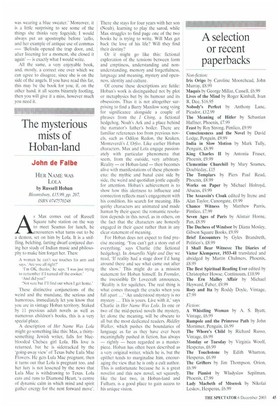The mysterious mists of Hoban-land
John de Falbe
HER NAME WAS LOLA by Russell Hoban Bloomsbia,, £15,99, pp. 207, ISBN 0747570248 Ats Max comes out of Russell Square tube station on the way o meet Seamus for lunch, he ncounters what turns out to be a demon, set on him by Lola. It is a sniffling, belching, farting dwarf conjured during her study of Indian music and philosophy to make him forget her. Then:
A woman he can't see touches his arm and says. Are you all right?'
'I'm OK, thanks,' he says. 'I was just trying to remember if I turned off the cooker.' And did you?'
Not sure hut I'll find out when I get home.'
These distinctive conjunctions of the weird and the mundane, the serious and humorous, immediately let you know that you are in vintage Hoban territory. Staked by 11 previous adult novels as well as numerous children's books, this is a very special place.
A description of Her Name Was Lola might go something like this: Max, a thirtysomething Jewish writer, falls for blueblooded Chelsea girl Lola. His love is returned, but he is sidetracked by the 'going-away view' of Texas babe Lula Mae Flowers. He gets Lula Mae pregnant, then it turns out that Lola is pregnant too, and her fui-yr is not lessened by the news that Lula Mae is withdrawing to Texas. Lola cuts and runs to Diamond Heart, 'a centre of dynamic calm in which mind and spirit gather energy for the next forward move'.
There she stays for four years with her son (Noah), learning to play the sarod, while Max struggles to find page one of the two books he is trying to write. Will Max get back the love of his life? Will they find their destiny?
Or it might go like this: fictional exploration of the tensions between form and emptiness, understanding and nonunderstanding, memory and forgetfulness, language and meaning, mystery and openness, identity and culture.
Of course these descriptions are futile: Hoban's work is distinguished not by plot or metaphysics but by its humour and its obsessions. Thus it is not altogether surprising to find a Barry Manilow song vying for significance alongside a couple of phrases from the I Ching, a fictional hedgehog, Noah's Ark and a place behind the narrator's father's boiler. There are familiar references too from previous novels, such as Odilon Redon, the Kraken, Monteverdi's L'Orfeo. Like earlier Hoban characters, Max and Lola engage passionately with particular phenomena that seem, from the outside, very arbitrary. Reality — or Hoban-land — then becomes alive with manifestations of these phenomena: the mythic and banal exist side by side, the weird and quotidian jostle equally for attention. Hoban's achievement is to show how this alertness to influence and connection reflects man's engagement with his condition, his search for meaning. His quirky characters are animated and made human by their quest: the romantic resolution depends in this novel, as in others, on the fact that the characters are honestly engaged in their quest rather than in any clear statement of meaning.
For Hoban does not expect to find precise meaning. 'You can't get a story out of everything,' says Charlie (the fictional hedgehog). In Amaryllis Night and Day we read, 'If reality had a stage door I'd hang around there and see what came out after the show.' This might do as a mission statement for Hoban himself. In Fremder, the irresistible Dr Lovecraft announces, 'Reality is for squilches. The real thing is what comes through the cracks when you fall apart ..."An understood mystery is no mystery ... This is yours. Live with it,' says Charlie in Her Name Was Lola. In one or two of the mid-period novels the mystery, let alone the meaning, will be obscure to all but the most dedicated readers. Riddley Walker, which pushes the boundaries of language as far as they have ever been meaningfully pushed in fiction, has always — rightly — been regarded as a masterpiece. Hoban has often been described as a very original writer, which he is, but the epithet tends to marginalise him, encouraging the view that he is only a cult author. This is unfortunate because he is a great novelist and this new novel, set squarely, like the last two, in Hoban-land and Fulham, is a good place to gain access to his unique vision.


























































































 Previous page
Previous page